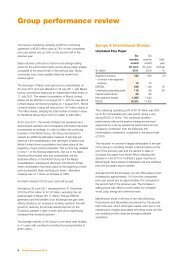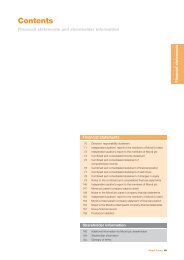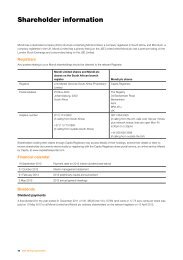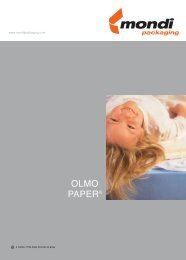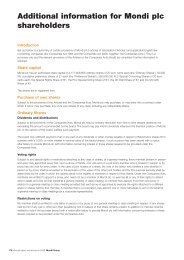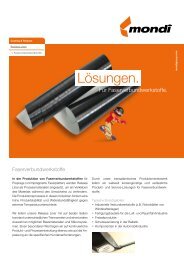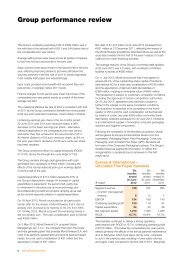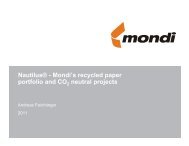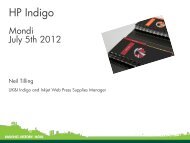Notes to the combined and consolidated financial statements - Mondi
Notes to the combined and consolidated financial statements - Mondi
Notes to the combined and consolidated financial statements - Mondi
Create successful ePaper yourself
Turn your PDF publications into a flip-book with our unique Google optimized e-Paper software.
<strong>Notes</strong> <strong>to</strong> <strong>the</strong> <strong>combined</strong> <strong>and</strong><br />
<strong>consolidated</strong> <strong>financial</strong> <strong>statements</strong> continued<br />
for <strong>the</strong> year ended 31 December 2009<br />
1 Accounting policies (continued)<br />
The recoverable amount of <strong>the</strong> asset, or cash-generating unit, is <strong>the</strong> higher of its fair value less costs <strong>to</strong> sell <strong>and</strong> its value in use.<br />
In assessing value in use, <strong>the</strong> estimated future cash flows generated by <strong>the</strong> asset are discounted <strong>to</strong> <strong>the</strong>ir present value using a<br />
pre tax discount rate that reflects current market assessments of <strong>the</strong> time value of money <strong>and</strong> <strong>the</strong> risks specific <strong>to</strong> <strong>the</strong> asset for<br />
which estimates of future cash flows have not been adjusted.<br />
If <strong>the</strong> recoverable amount of an asset, or cash-generating unit, is estimated <strong>to</strong> be less than its carrying amount, <strong>the</strong> carrying<br />
amount of <strong>the</strong> asset, or cash-generating unit, is reduced <strong>to</strong> its recoverable amount. An impairment is recognised immediately as an<br />
expense. Where an impairment subsequently reverses, <strong>the</strong> carrying amount of <strong>the</strong> asset, or cash-generating unit, is increased <strong>to</strong><br />
<strong>the</strong> revised estimate of its recoverable amount, but so that <strong>the</strong> increased carrying amount does not exceed <strong>the</strong> carrying amount<br />
that would have been determined had no impairment been recognised for <strong>the</strong> asset, or cash-generating unit, in prior years.<br />
A reversal of an impairment is recognised in <strong>the</strong> <strong>combined</strong> <strong>and</strong> <strong>consolidated</strong> income statement immediately.<br />
Owned forestry assets<br />
Owned forestry assets are measured at fair value. The fair value is calculated by applying <strong>the</strong> expected selling price, less costs <strong>to</strong><br />
harvest <strong>and</strong> deliver, <strong>to</strong> <strong>the</strong> estimated volume of timber on h<strong>and</strong> at each reporting date. The estimated volume of timber on h<strong>and</strong> is<br />
calculated by applying <strong>the</strong> mean annual increment for each age class, by species, <strong>to</strong> <strong>the</strong> area under afforestation. The product of<br />
<strong>the</strong>se is <strong>the</strong>n adjusted <strong>to</strong> present value by applying a current market determined pre tax discount rate. Mature forestry assets are<br />
those plantations that are harvestable, while immature forestry assets have not yet reached that stage of growth. Plantations are<br />
considered harvestable after a specific age depending on <strong>the</strong> species planted <strong>and</strong> regional considerations.<br />
Changes in fair value are recognised in <strong>the</strong> <strong>combined</strong> <strong>and</strong> <strong>consolidated</strong> income statement within ‘o<strong>the</strong>r net operating expenses’.<br />
At point of felling, <strong>the</strong> carrying value of forestry assets is transferred <strong>to</strong> inven<strong>to</strong>ry.<br />
Directly attributable costs incurred during <strong>the</strong> year of biological growth <strong>and</strong> purchases of st<strong>and</strong>ing timber are capitalised <strong>and</strong><br />
presented within cash flows from investing activities in <strong>the</strong> <strong>combined</strong> <strong>and</strong> <strong>consolidated</strong> statement of cash flows.<br />
Non-current assets held for sale <strong>and</strong> discontinued operations<br />
Non-current assets, <strong>and</strong> disposal groups, classified as held for sale are measured at <strong>the</strong> lower of carrying amount <strong>and</strong> fair value<br />
less costs <strong>to</strong> sell.<br />
Non-current assets, <strong>and</strong> disposal groups, are classified as held for sale if <strong>the</strong>ir carrying amount will be recovered through a sale<br />
transaction ra<strong>the</strong>r than through continuing use. This condition is regarded as met only when it is highly probable <strong>and</strong> <strong>the</strong> asset, or<br />
disposal group, is available for immediate sale in its present condition. Management must be committed <strong>to</strong> <strong>the</strong> sale, which should<br />
be expected <strong>to</strong> qualify for recognition as a completed sale within one year from <strong>the</strong> date of classification.<br />
Non-current assets are classified as held for sale from <strong>the</strong> date <strong>the</strong>se conditions are met <strong>and</strong> are measured at <strong>the</strong> lower of carrying<br />
amount <strong>and</strong> fair value less costs <strong>to</strong> sell. Any resulting impairment is reported through <strong>the</strong> <strong>combined</strong> <strong>and</strong> <strong>consolidated</strong> income<br />
statement as a special item. On classification as held for sale, <strong>the</strong> assets are no longer depreciated. Comparative amounts are<br />
not adjusted.<br />
Discontinued operations are classified as held for sale <strong>and</strong> are ei<strong>the</strong>r a separate major line of business or geographical area of<br />
operations that have been sold or are part of a single co-ordinated plan for disposal, or represent a subsidiary acquired exclusively<br />
with a view <strong>to</strong> sale. Once an operation has been identified as discontinued, or is reclassified as continuing, <strong>the</strong> comparative<br />
information is restated.<br />
Current non-<strong>financial</strong> assets<br />
Inven<strong>to</strong>ry<br />
Inven<strong>to</strong>ry <strong>and</strong> work-in-progress are valued at <strong>the</strong> lower of cost <strong>and</strong> net realisable value. Cost is determined on <strong>the</strong> first-in-firs<strong>to</strong>ut<br />
(FIFO) or weighted average cost basis, as appropriate. Cost comprises direct materials <strong>and</strong> overheads that have been incurred<br />
in bringing <strong>the</strong> inven<strong>to</strong>ries <strong>to</strong> <strong>the</strong>ir present location <strong>and</strong> condition. Net realisable value is defined as <strong>the</strong> selling price less any<br />
estimated costs <strong>to</strong> sell.<br />
88 Annual report <strong>and</strong> accounts 2009 <strong>Mondi</strong> Group



